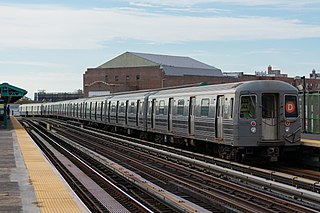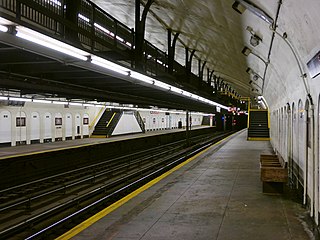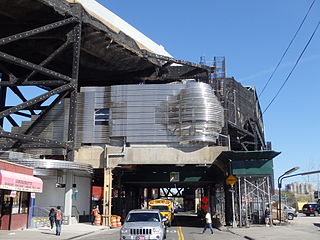
The Cathedral Parkway–110th Street station is a local station on the IND Eighth Avenue Line of the New York City Subway. It is located in the Upper West Side and Morningside Heights, Manhattan, at West 110th Street and Frederick Douglass Boulevard at the northwest corner of Central Park. The station is served by the B on weekdays, the C train at all times except nights, and the A train during late nights only.
The IND Culver Line is a rapid transit line of the B Division of the New York City Subway, extending from Downtown Brooklyn south to Coney Island, Brooklyn, New York City, United States. The local tracks of the Culver Line are served by the F service, as well as the G between Bergen Street and Church Avenue. The express tracks north of Church Avenue are used by the <F> train during rush hours in the peak direction. The peak-direction express track between Ditmas Avenue and Avenue X has not seen regular service since 1987.

The D Sixth Avenue Express is a rapid transit service in the B Division of the New York City Subway. Its route emblem, or "bullet", is colored orange, since it uses the IND Sixth Avenue Line in Manhattan.

The 181st Street station is a station on the IND Eighth Avenue Line of the New York City Subway. It is located beneath Fort Washington Avenue in the Hudson Heights section of the Washington Heights neighborhood, between 181st and 184th Streets. The station is served by the A train at all times.

The 34th Street–Herald Square station is an underground station complex on the BMT Broadway Line and the IND Sixth Avenue Line of the New York City Subway. It is located at Herald Square in Midtown Manhattan where 34th Street, Broadway and Sixth Avenue intersect, and is served by the D, F, N, and Q trains at all times; the R train at all times except late nights; the B, M, and W trains on weekdays; and the <F> train during rush hours in the peak direction.

The Church Avenue station is an express station on the IND Culver Line of the New York City Subway. Located at Church and McDonald Avenues in Kensington, Brooklyn, it is served by the F and G trains at all times, and by the <F> train during rush hours in the peak direction.

The Carroll Street station is a local station on the IND Culver Line of the New York City Subway, located in the neighborhood of Carroll Gardens, Brooklyn, at Carroll and Smith Streets. It is served by the F and G trains at all times.

The Bergen Street station is a station on the IND Culver Line of the New York City Subway, located at the intersection of Bergen Street and Smith Street on the border of Cobble Hill and Boerum Hill in Brooklyn. It is served by the F and G trains at all times.

The Seventh Avenue station is an express station on the IND Culver Line of the New York City Subway, located at Seventh Avenue and Ninth Street in the Park Slope neighborhood of Brooklyn. It is served by the F and G trains at all times, and by the <F> train during rush hours in the peak direction.

The 145th Street station is a bi-level express station on the IND Eighth Avenue and Concourse lines of the New York City Subway, located at the intersection of 145th Street and St. Nicholas Avenue in Harlem and Hamilton Heights, Manhattan. It is served by the A and D trains at all times, by the C train at all times except late nights, and by the B train on weekdays only.

The 175th Street station is a station on the IND Eighth Avenue Line of the New York City Subway. Located in the Washington Heights neighborhood in Upper Manhattan, at the intersection of 175th Street and Fort Washington Avenue, it is served by the A train at all times.

The Smith–Ninth Streets station is a local station on the IND Culver Line of the New York City Subway. It is located over the Gowanus Canal near the intersection of Smith and Ninth Streets in Gowanus, Brooklyn, and is served by the F and G trains at all times. The station is 87.5 feet (26.7 m) above ground level and was the highest rapid transit station in the world when it was built.

The West Eighth Street–New York Aquarium station is a New York City Subway station, located on the BMT Brighton Line and IND Culver Line in the Coney Island neighborhood of Brooklyn. The station is located over the private right-of-way of the defunct New York and Coney Island Railroad north of Surf Avenue, running easterly from West 8th Street. It is served by the F and Q trains at all times, and by the <F> train during rush hours in the peak direction. This station is geographically the southernmost station in the entire New York City Subway system.

The Parsons Boulevard station is an express station on the IND Queens Boulevard Line of the New York City Subway. Located at the intersection of Parsons Boulevard and Hillside Avenue in Queens, it is served by the F train at all times, the <F> train during rush hours in the reverse peak direction, and a few rush-hour E trains.

The Bay Parkway station is a local station on the IND Culver Line of the New York City Subway, located in Midwood, Brooklyn at the intersection of Bay Parkway and McDonald Avenue above Washington Cemetery. It is served by the F train at all times and the <F> train during rush hours in the peak direction.

The 15th Street–Prospect Park station is a local station on the IND Culver Line of the New York City Subway. Located at 15th Street east of Prospect Park West in the Windsor Terrace and Park Slope neighborhoods in Brooklyn, it is served by the F and G trains at all times.

The York Street station is a station on the IND Sixth Avenue Line of the New York City Subway. It is served by the F train at all times and the <F> train during rush hours in the peak direction. It is located at York Street and Jay Street in Dumbo and is the only Sixth Avenue Line station in Brooklyn.

The Woodhaven Boulevard station is a local station on the IND Queens Boulevard Line of the New York City Subway, consisting of four tracks. Located in Elmhurst, Queens, it is served by the M train on weekdays, the R train at all times except nights, and the E and F trains at night. The station serves the adjacent Queens Center Mall, as well as numerous bus lines.

The Fourth Avenue/Ninth Street station is a New York City Subway station complex shared by the elevated IND Culver Line and the underground BMT Fourth Avenue Line. It is located at the intersection of Ninth Street and Fourth Avenue in Park Slope, Brooklyn and served by the:

The Jay Street–MetroTech station is a New York City Subway station complex on the IND Fulton Street, IND Culver, and BMT Fourth Avenue lines. The complex is located in the vicinity of MetroTech Center in Downtown Brooklyn. It is served by the A, F, and R trains at all times; the C train at all times except late nights; the N train during late nights only; and a few rush-hour W and <F> trains in the peak direction.

























